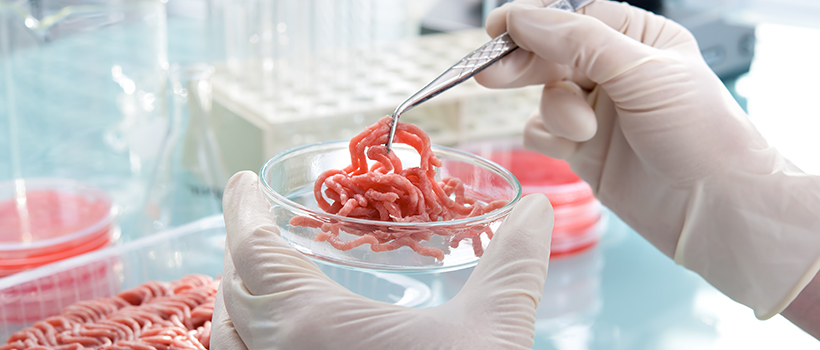
Cultivating meat for space missions
17 July 2023 | Craig Leadley, Technology Fellow
When I began my career in food technology, I did not expect the profession to take me to the Europe Space Agency. However, the food industry and space exploration are not as far removed as they may first appear…
Today’s HACCP (Hazard analysis and critical control points) system – for identifying, managing and controlling food safety hazards in food and drink production – started as a 1960s effort to ensure safe food for astronauts during space missions.
Now, I am working with Kayser Space and Cellular Agriculture Ltd on a European Space Agency project to explore the cultivation of meat for space missions.
What is cellular agriculture and cultivated meat
Cellular agriculture is the use of cell culture (cultivating cells in controlled environment, such as a laboratory or bioreactor) techniques to produce ingredients and food products.
Among the theoretically endless possibilities of products that could be produced by this method is cultivated meat, which is made by propagating animal cells in a bioreactor. An outline of the overall process is as follows:
Small amount of issue taken from an animal
Stem cells isolated
Stem cells grown in a bioreactor with nutrients
Stem cells differentiated to muscle fibres in a bioreactor
Product formulation
Here on earth, meat products continue to be popular and there is also a growing interest in cellular agriculture, cultivated meat and precision farming. For more about the commercialisation of cultivated meat, check out the blog from our regulatory team.
For space missions, especially long terms ones (years rather than days), size, weight and other constraints are such that meeting the protein needs of astronauts is a big challenge. So, that’s where this project comes in.
The project and partners
The aims:
- Assess the capability of cellular agriculture for cultivated meat production
- Frame this capability in the context of sustainability, food security and human health safety
- Assess resources needed, energy balance and potential for a closed loop system
- Identify and evaluate bioreactor technology best suited for utilisation in space
The project was led by the space research company Kayser Space Ltd, and has received invaluable support from The European Space Agency. Cellular Agriculture UK – the first UK startup in the cultured protein field – were brought in to design the bioreactor for the cell culture.
Our role was to advise on the nutritional and food safety system elements. Our first task was to evaluate various protein sources – of which cultivated meat was one - to assess their suitability for the challenge at hand.
The challenge
The project was based around a scenario of a 1200 days (which is approximately 3.5 years) mission to Mars, to be undertaken with 4 crew members.
Based on the protein requirements of astronauts (from International Space Station consumption data), and 4 crew members, 240g of protein will be needed per day. As well as being able to produce the protein needs of the astronauts, the bioreactor for producing the cultivated meat would also need to fit within an International Standard Payload Rack (ISPR), which is 1.5m3 and up to 700kg.
We assessed a number of options for onboard protein production and cultivated meat was found to be the best suited to the task due to palatability (important for astronaut morale) and amino acid profile (with respect to the 11 essential amino acids that we need our diets to provide). Based on the selected cultivated meat solution, we calculated a daily crew need of 1.2kg of cultivated meat. We conservatively estimated that 20% (240g) of this would be protein.

Where are we now?
The closed system of a space environment creates quite the challenge, but great progress was made in this project. A theoretical design was produced that met the required duty. There have been a number of areas identified for further research, including how to fulfil the need for practical, in-situ generated inputs to the bioreactor (of which glucose is the largest, followed by oxygen). Another area of further work is to address how by-products will be managed (for example lactate), ideally through waste recycling.
So, what’s next? We hope that the team can continue to collaborate and we have an approximate timeline mapped out for studies until at least 2045. We are discussing how to design future work which can address the research gaps identified on the project.
We hope that we can secure further funding to conduct practical trials on the International Space Station (a micro-scale version of the bioreactor), followed by a scaled up version of the testing (including tasting by astronauts and eventual introduction of the cultivated meat product into astronaut diets). The goal is for terrestrial mass production using the project’s bioreactor technology, and the design of a space bioreactor and supporting infrastructure for a long term space mission.
Harnessing science and technology to support your business
We have been undertaking pioneering research for over 100 years. We provide a wide range of services and products, all underpinned by investment in meaningful research and science.
If you need help with nutrition, food safety, alternative protein sources, cellular agriculture, or other new technologies, get in touch for support.
Check out our case studies for more information on the sorts of innovative projects that we support our clients with. Whatever challenge you are working on, we can help you get the answers you need.
How can we help you?
If you’d like support with alternative proteins, cellular agriculture, food safety or nutrition, contact our support team to find out how we can help.
Are you a Campden BRI member who attends the MIG meetings?
- If not, you’re missing out on a whole host of exclusive benefits such as learning from industry-leading experts and networking with peers to overcome your challenges.







